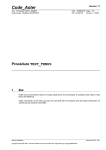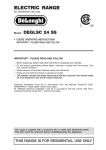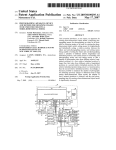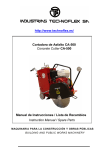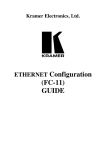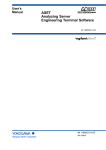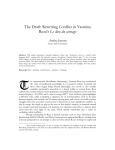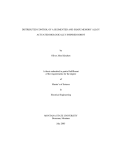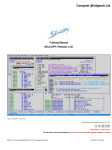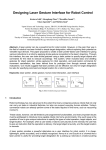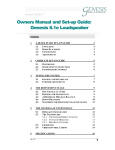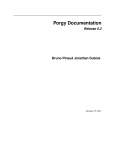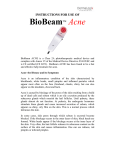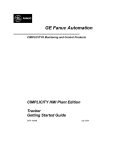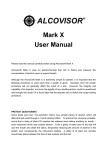Download An Investigation for Integrated User Interface of Home
Transcript
An Investigation for Integrated User Interface of Home Appliances Based on User’s Cognitive Structure Sang-Hee Hong* and Kenta Ono ** * Kangwon National University, Department of Industrial Design Korea, [email protected] ** Chiba National University, Department of Industrial Design Japan, [email protected] Abstract: There are numerous home appliances equipped with various operation and user interface under the catch phrase of modernized human convenience improvement. However, on the contrary to the original intention, the user’s burden is getting bigger and bigger. If this burden is solved, the user can have easy access to the convenient way while the manufacturer can appeal to the user for the real meaningful convenience of the products. The aim of this study was focused on the acquisition of guideline for integrated user interface design by common interface operation of user cognitive map. In order to get this purpose, it suggested the control key design of rotary mode as the common factor of washing machine, microwave oven, and electric rice cooker. For the appropriateness and validity of the interface operation, three kinds of home appliances were tested twice for 3degrees of difficulty in use. As a result, the decreasing error of the second experiment showed that the repeated operation would get down the number of the error. Stratification of the thirty kinds of errors revealed that repeated use of novel operation and common interface could make the system combined with universal design. The integration of the interface design of the home appliances could set up the guide post and identity of the manufacturer by dint of the specification of the control key. Key words: User Interface Design, Cognitive Map, Home Appliances Design 1. Introduction The accelerated digitalization of home appliances has made the consumer confused. The consumer has found it difficult to fit into the new product due to short buying cycle. Compared to the young aged user who is accustomed to new product and new environment, the old aged person needs more time to learn the operation manual of the home appliances. Why don’t we try to solve the problem of the user who is difficult to know how to work the machine? The answer is to make the user memorize the method by only one touch regardless of the knowledge. In the light of the manufacturer, the development of common user manual will secure the customer and make him familiar to company’s products. 1961 This study suggested the integration of the product operation system through the preceding research and proposed the new operation system [1]. The preceding investigation hypothesized that the operation system simulated human cognitive structure. The investigation proved that it was possible to establish the standard operation system based on the user’s cognitive structure. The researchers made a suggestion of unified operation manual of home appliances. Based on the integration control panel design of preceding research, this study proposed the control key of the rotary mode of integration operation. This type was applied to the protocol experiment. As a result, the efficacy and validity of integration user interface was proved. By dint of the protocol test, the authors also examined the practicability of the suggestion. 2. The Outline of the preceding investigation Under the hypothesis that the real operation system has a near resemblance with the human cognition (unless the error occurs or the error is easy to solve), the operation system of memory planted in human brain should be different from that of real operation system in this investigation. The researchers made the 60 respondents of 30 to 60 years old describe by their own memory to the operation manual and frequently used operation button of washing machine, microwave oven, and rice cooker. The researchers chose washing machine, microwave oven and rice cooker as the experiment group for the analysis of frequently used home appliances. These factors were selected for ‘direct operation’ and ‘simple operation’ which were defined from ‘Extracting the operation characteristics for integrated interface construction of the network electronics’ [2]. This description continued twice in actual survey of the products. As a result, the respondents remembered 35 kinds of operation of home appliances and the sequence was always three processes of power switch→set point→start. In order to know the difference between the memory and the actual survey, combination of the higher percentage of correct answers and the lower percentage of wrong answers was the key to the standard operation system management. In washing machine, power switch→start→set point sequence was converted into power switch→set point→start sequence. This conversion made it possible for user to operate smoothly. Combination of rotary type operation system and indicator could simplify the operation and adapt the power button to user cognition structure in microwave oven. In rice cooker, power button was set up in accordance with other home appliances and user cognition structure. Figure 1. Suggestion of integrated control panel of washing machine, microwave oven, and rice cooker. 1962 Figure 1 showed the integrated control panel on the basis of this result. The design of the integrated user interface was made to satisfy the user cognition structure. If this kind of design were applied to the real products, the design should meet the user’s intention and convenience. If the real products were come in based on the design, the efficacy and validity would be examined. 3. Outline and Method 3.1 Outline Based on the integrated control panel of preceding research, establishment of mode selection into rotary type switch had the operation system in common with each other. The unification of rotary type selection button made the operation system (Figure 2). Figure 2. Design concept of integrated control key and its tested model In order to reveal the validity and efficacy for interface operation of three kinds of products, the researchers carried out the test. The experiment was designed to show the’ power on’ and ‘power off’ in PC screen. The operation in user was made by control key. With a view to satisfying the purpose and accuracy, self-made Prototype Mock-up was furnished to the testees by using the rotary control button. Following is the explanation of each operation system. In order to examine the troubleshooting of various products as the crossing concept, USB embedded Prototype Mock-up was used to show the similar interface operation of washing machine, microwave oven and rice cooker to the testees. Five parameters (washing, rinse, dehydration, dry and reservation) of rotary type control key were established in washing machine and mode selection such as dirty washing and hand washing was input to the machine. In microwave oven control panel, start button is adopted in recent marketing in accordance with the human cognition structure [2]. In the meanwhile, in order to provide the easy use, every operation system includes the Nominal Scale that tells the side dish, rice, and milk etc [3]. The less frequently used time and temperature input was programmed into software, and the operation is set to default value of automatic. The rice cooker was set to three parameters of warming, course selection, and reservation. Each parameter was freely put to rotary key. The operation structure, menu selection and interface of microwave oven and rice cooker were described by way of the real products. 1963 The researchers made the background recording possible whether what kind of operation would be done. This test design makes it possible that right and left turn of rotary key and up and down button were put into record. Afore-mentioned explanation proved to be valid and effective in unified interface by way of software guided protocol test [4]. 3.2 Method Three products of task were selected for the protocol test. Three levels of task consisted of frequently used work, less frequently used work and rarely used work of many parameters in preceding investigation. 1) Washing machine a. strong/dirt washing selection task b. Task of three times of rinse in high speed course c. Tasks that select all parameters, washing, rinse, dehydration and reservation 2) Microwave oven a. Heating the side dishes b. Set up to heat for 2 minutes c. Set up temperature of ‘100℃ is changed into the next set up temperature of ‘10℃’(In case of microwave oven, there is no complicated procedure, temperature change is the degree of difficulty) [5]. 3) Rice cooker a. Operation of standard course (polished rice) b. Reservation of ‘3 H’ in high speed c. Warming of standard course (In case of rice cooker, due to simple operation, it is substituted into rarely used start-rewarming or side dish warming) Three groups of testees were nine persons of twenties and thirties. A group : Learned the microwave operation and tested the washing machine and rice cooker. B group : Learned the washing machine operation and tested the microwave oven and rice cooker. C group : Learned the rice cooker operation and tested the washing machine and microwave oven. Familiarity test was done by analysis of operation time from the next-day test group and seventh-day test group. Operation procedures, perlocutionary content, operation button, occurrence time, action from the video tape were all recorded [6]. After this examination, two kinds of data were integrated. Protocol and operation were derived from the data. Erroneous parts were extracted from the data. The extraction of error was thought to come from the perlocutionary content and time passage. In the light of the perlocutionary content, the wrong side and longer time interval were considered to be the error. 4. Demonstration of the validity and efficacy of the integrated control key 4.1 The structural understanding of the integrated control key Notwithstanding the only one explanation of the operation method, there was no problem in operating the other home appliances. The testees could understand the operation system without difficulty and they could have in 1964 common with product experience each other. The more numbers the operator has, the less time it takes to terminate. The integrated control key will improve the operation efficiency by experience and learning skill. Table 1 showed the goal achievement time difference in nine persons. Table 1. Goal achievement time difference (Initial-retrial(second)) Washing Machine1 Washing Machine2 Testee A Testee B Testee C Testee D Testee E Testee F -4 -5 -3 1 2 2 Testee G Testee H Testee I -2 -5 -2 Washing Machine3 Microwave Oven1 Microwave Oven2 4 -3 -2 -5 -10 -1 6 -11 0 2 1 3 -3 -19 -4 1 -33 6 Average reducing time of seven day later group -3 -10 1 -1 5 -1 -4 -1 0 Average reducing time of the next day group Microwave Oven3 0 0 2 10 9 2 -3 -22 -43 -52 -16 -4 -2 2 -3 -38 -48 -13 Total -8 -43 -49 -35 -31 -26 -32 -54 -48 -23 -42 The average reducing time of the next day group was 41 seconds reduction, and seven day later group proved to be 32 seconds reduction. This investigation had smaller group of persons, but improvement of the reducing time revealed that the learning effect turned out to be fruitful. 4.2 The learning effect of the integrated control key Table 2 showed the error occurrence in the experiment. The second trial revealed reduced error and most of the persons had half of the error. Unified interface could overcome the operation difficulty and this prove to be effective learning. Table 2. Diminution of errors (First time-second time) First time test Second time test Question Washing Machine1 Washing Machine2 Washing Machine3 Microwave Oven1 Microwave Microwave Total Oven2 Oven3 Testee A 1 1 3 1 2 4 Washing Machine1 Washing Machine2 Washing Machine3 Microwave Oven1 Microwave Oven2 Microwave Oven3 Total 12 1 2 5 0 0 3 11 Testee B 0 1 1 0 5 2 9 1 1 1 1 0 4 8 Testee C 1 6 8 1 3 2 21 2 0 2 0 2 2 8 Testee D 1 2 5 3 1 2 14 1 0 1 3 5 5 15 Testee E 1 1 5 3 4 5 19 0 1 3 0 9 3 16 Testee F 1 1 5 1 4 7 19 1 0 1 6 2 5 15 Testee G 2 5 4 4 5 3 23 0 1 4 1 1 4 11 Testee H 1 1 5 3 5 4 19 0 2 1 1 2 4 10 5 22 3 5 4 1 2 5 20 Testee I 2 5 5 4 1 5. Stratification of error for the validation of integrated user interface What kinds of error did exist? Thirty kinds of error were enumerated in table 3. The errors were confusion in the first use, search for the goal course in initial screen, difficulty in path finding, confusion course with input indicator. The errors could be summarized into thirty. 1965 Table 3. Diminution of errors (First time-second time) 30 kinds of errors are found by operation record and answer sheet •Do not know what to do at first •Do not use the clear menu •Find course menu in initial screen •Do not know the null variable input •Go unnotice the initial screen •Expect the variable input cycle •Do not understand the course menu •Pass the variable input •Do not know present course menu •Input error in variable •Confuse the course menu and input sign •Unnecessary operation after input •Overlook the course menu •Confuse how to terminate the input mode •Pass the course menu •Do not connect the goal with GUI •Select the another menu •Confuse right and left turns •Overlook the selection within the course •Fix the device at the crossing point •Do not know the course cycle •Do not connect •Return to previous menu •Confuse the start button and clear •Do not know the next course selection •Confuse how to operate with the key menu •Do not know the clear menu •Operate the wrong key menu •Do not know how to use the clear menu •Continue the next menu with wrong input GUI with device The meaning of the selected 30 items has the relationship with super ordinate concept and subordinate concept, and two concepts include each other. In order to make a ladder style structure from the error, Graph Theory priority method was used [7]. In consideration for standard error versus comparative error, priority toward the individual error data were recorded. For example, the variable was impossible to input in case of ‘do not know what to do in initial action’. It reflected in the error of no input data. The analysis of priority method led to a ladder style stratification. With the data, stratification was got from the priority analysis. Figure 3 showed the ladder style stratification structure made by priority method. The first ladder, hesitation in the initial action was followed by the seven ladders. Five steps of questionnaire were made in order to provide a better understanding ; the error in the first initial questionnaire, the decreasing error in the second item below, the first and second error in the same product, the decreasing error in the second product, in the second test, the decreasing error in two products, and unimproved error. As a result, in the right side, half of the error (sixth step) showed decrease from the second product. The other errors decreased in the second test. Errors by operation interruption are gathered in the left side. In consideration for these facts, structure of error was summarized in six groups such as top and bottom, left and right route, the tested product and the other product. The six errors are, 1. Error by inexperience : The uppermost structural stage → the initial error 2. Habit and prejudice of the user : the upper stage → wrong memory or error by operation of past experience 3. Not experienced : the middle right stage of the structure → error by unskilled operation 4. Impatience and confusion : the lower right stage of the structure → unintentional error 5. Operational error : the middle left stage of the structure → complete error 6. Refusal by user’s decision : the lower left stage of the structure→ reckless decision or confusion 1966 Among the six errors, 3. Not experienced : the middle right stage of the structure → error by unskilled operation 4. Impatience and confusion : the lower right stage of the structure → unintentional error These two errors proved to be overcome by experience. In the meanwhile, 5. Operational error : the middle left stage of the structure → complete error 6. Refusal by user’s decision : the lower left stage of the structure→ reckless decision or confusion These errors can occur at any time, but it turned out that the method to reduce the errors was necessary and essential. Figure 3. Error stratification by protocol analysis For instance, the best ways are cancellation of the operation or information of the operation to the user. That is to say, the feedback system that tells the possibility of the errors to user. This corresponds to the fifth of the seven universal design principles (i.e., Tolerance for Error) and this is the thoughtful consideration for the user ’s convenience. In conclusion, although unified interface cannot be the unique system that needs habit or skill, it can be fully overcome by learning. On the other hand, the clear system in operation was not easy system, clear system had room for improvement. The aforementioned two facts were the final conclusion of this study. 1967 6. Conclusions This study suggested the integrated user interface design based on the user’s cognition structure in keeping pace with user’s convenience, marketing strategy of the manufacturer, and digital revolution of technology. The experiment showed that the sequence was always three processes of power switch→set point→beginning and planted in the user’s memory. Through finding out the difference between user’s memory and real products, it was possible to draw up the integrated operation system which fitted into user’s cognitive structure of washing machine, microwave oven, and rice cooker. Design of the rotary type control key based on the operation system led to the validity and efficacy of the interface operation of the three products. In the initial stage the newly designed integrated control key made lots of errors, but it revealed the improvement of operation efficiency through experience and learning of the user. The operational errors of experiment were analyzed into error stratification for solution. The errors were 6 groups and most of these errors could be corrected by experience and learning. The complete error or refusal of the user had room for improvement by dint of combination with other areas. The operational complexity and error can be solved by instrumental basis [3]. The introduction of Universal Design is essential in this situation. The integrated user interface was defined as the unique instrumental system that needs habit, but the interface could be overcome by learning. The insufficient system of Clear button also had room for improvement. In conclusion, unified interface is not the philosopher’s stone but the realizable design element. 7. References and Citations [1] Sang-Hee Hong(2009) A study on unified user interface design of home appliances. In Proceeding of the Biannual Design Conference of KSDS 2009, SNU Press, pp 230-231. [2] Sang-Hee Hong(2008) Extracting the operation characteristics for integrated interface construction of the network electronics. In Proceeding of KSES Conference 2008, pp 102-105. [3] Sang-Hee Hong, Sang-Young Shin, Kenta Ono(2007) Analysis the UI trend of appliances and its visualized structure, Journal of KSDS, vol. 20, no. 4, pp 333-342. [4] Jung-Mo Lee(2006) Cognitive Psychology. Hakjisa. [5] In Korea, ‘warming time’ button ‘ is first input, but in Japan, only one button of ‘warmimg’ is input and terminated in action. [6] Perlocutionary : the record that the tested persons talked to themselves during the test, for example, ‘My Godness!’, ‘Ouch!’ [7] K. Sugiyama, K. Inoue(1996) Primer to investigation analysis by Excel, Kaibundo. 1968









